As many readers will already know, it is possible to make research open access through two main routes: (1) paying a publisher for immediate open access (this is known as “gold” open access) or (2) publishing in a subscription journal but exercising the right to re-use an accepted manuscript in a repository (“green” open access).
A gold open access article might be an article in a fully open access journal or a hybrid journal (i.e. a subscription journal that offers an option to pay for open access, and which therefore publishes a mixture of subscription-only and open access articles). It should also be noted that many fully open access journals do not charge open access fees (see many examples at DOAJ).
In addition to these routes, you might post unpublished work to pre-print servers (like arXiv, bioRxiv or PsyArXiv) in order to make this work open access as well as to elicit peer review and gain recognition for it before it is even published.
Here at LSHTM, we support authors following both the gold and green routes to open access. We’ve noted enthusiasm from researchers for the various benefits of open access regardless of how the work ends up being made open. We’ve seen a year-on-year rise on open access at the School, with less than 20% of articles being open access via a hybrid or fully open access journal in 2001, compared to around 60% in 2017. In the figure below, the ‘hybrid’ category includes some publications that are open by default, such as Health Technology Assessment and the Bulletin of the World Health Organisation, but which aren’t captured in the category ‘open access journal’ (defined by DOAJ). This contributes to the relative high percentage of open access publications in the early 2000s. On top of this, many of our researchers’ articles are free-to-read thanks to PubMed Central.
The figure shows our open access profile from 2001-2017 for research articles. The stats for 2017 are still ongoing with some articles still awaiting self-archiving in the School’s repository (LSHTM Research Online) and deposit in PubMed Central. Just over 30% of the School’s 2017 articles are not recognized to be currently open access via the gold route or through deposit of the full-text in PubMed Central. However, of these articles published in hybrid or subscription-only journals approximately half can be expected to be archived in LSHTM Research Online by the end of the year. Overall, this means that by the end of the year at least 80% of the School’s research articles published in 2017 should be open access via the gold or green route. Yet, from this we can see that work is still to be done in the push towards 100% open access.
Figure. LSHTM open access articles by type 2011-2017 (acknowledgement: Andy Reid)
It is worth saying in the context of these numbers that the School is in a reasonably unique situation in that the vast majority of the journals our research is published in is indexed in PubMed. Our in-house research information system (called Publications Database) receives records of new publications deposited in PubMed and in turn feeds records into our repository without author mediation. This means that we can present a reasonably accurate overall open access profile in that we are not excluding a great number of publications which have not been captured by the research information system (though a small percentage of of articles may only be captured manually later on, usually when a researcher’s chosen journal falls outside those automatically indexed by PubMed).
Not all open access is equal
The number of our publications going into fully open access journals has also risen year-on-year since 2001. The proportion of publications finding their way into journals run by publishers like PLOS and BioMed Central is pushing towards 40%. Interestingly, the percentage of articles being made open access via hybrid journals has increased only slightly since the early 2000s, though this is admittedly biased by what is included in the category of ‘hybrid’, as mentioned above, as well as what articles have been captured by the research information system.
The rise of fully open access journals is also reflected in the number of APCs (article processing charges, i.e. open access fees) the Research Publications Team at the School has processed since last October. The School has funds available for authors funded by the RCUK (e.g. MRC, ESRC) and COAF (including Wellcome Trust and other charity partners like the British Heart Foundation and Cancer Research UK) to make their work “gold” open access. From these we have funded 244 open access articles between October 2016 and October 2017. Of these, 123 were for articles in fully open access journals, and 121 in hybrid journals (so around 50% of our APCs).
It’s worth noting how much we pay for these articles. Of the 123 articles in fully open access journals, the average price of an APC was £1677, compared to the average cost of a hybrid article at £2383. (We paid for several hybrid journal articles that were close to £5000 each). In other words, on average hybrid articles cost us over 40% or £700 more per article than articles in fully open access journals. A Wellcome Trust study from 2015 similarly indicated an average hybrid article was around £800 more than a fully open access article, and a broader study by Pinfield et al. (2015) also indicated that over a five year period fully open access journal APCs were around £700 cheaper than hybrid journals. It 2017 it is also apparent that, compared to the mean APCs noted in these 2015 studies, we’ve seen an increase of mean APC price of at least £300.
With finite funds provided by the Wellcome Trust and RCUK, which do not increase significantly year on year, it is not clear how sustainable the rising costs will be against the increase in requests for open access. Other universities have also noted this, and particularly question the “value for money” of hybrid journals. Others, including the University of Oxford and Imperial College London, have committed to using at least part of their open access funding for open access journals only.
Going forward, we will be encouraging use of discount schemes where these are cost effective. Largely due to the specialised nature of our School’s research, many LSHTM researchers publish in BioMed Central journals. We’ve found it to be worthwhile to sign up for a BioMed Central Membership, which offers 15% off APCs over a year. LSHTM researchers should be sure to make use of this discount when submitting to BioMed Central journals (see more on our intranet page [LSHTM Only]).
In the context of rising costs, we are also pleased to see the launch of Wellcome’s house journal Wellcome Open Research and the Bill & Melinda Gates Foundation’s Gates Open Research journal, which offer authors supported by those funders options to publish their work (gold) open access with no charge (for author or the School). We have already had one research article published in Wellcome Open Research.
And free does not always equal open
With the rise of open access policies, publishers are keen to demonstrate their commitment to open access, which is of course very welcome. However, for many publishers of subscription journals this has often taken the form of potentially misleading “free-to-access” content. We have seen that this causes confusion for authors, who think they are reading open access articles or believe that they have had their article published open access. This complicates our open access compliance processes, particularly for the next REF, which requires (in essence) accepted manuscripts to be self-archived in a repository like LSHTM Research Online or for articles to be published “gold” open access.
This Open Access Week, we’ve seen many examples of publishers promoting their free content, but we also see it throughout the year with promotional free-to-access periods. Publishers will often curate a series of articles to share for free for a limited period around international awareness days (like European Statistics Day or International Women’s Day). Furthermore, some journals routinely make a selection of articles free to read without subscription, as an editorial or promotional decision.
This can make open access compliance reporting problematic as systems can confuse them as “open access”. Furthermore, authors may send the final published version of their article for archiving in a repository, insistent that their work is open access because they see a certain label next to their article. Examples include publishers which tag articles as “free” or which use a green open padlock icon (see, for example, this selection of search results: you’ll see some closed padlocks and some green, open padlocks). These may indeed by free to read for a period of time, or they may just be accessible because the university’s library subscribes to that content, or they may be open access. It’s often unclear for many authors.
We appreciate content being made free to read since it widens access to the scholarly literature, but it should be clearer that these items are not always open access. “Access” to open access articles, particularly those with Creative Commons licenses, should be irrevocable.
To be sure what you are reading or what you have published is open access, look out for a Creative Commons license. The likelihood is it is not open access if the article says “free to read” and does not say “open access” or note a Creative Commons license.





